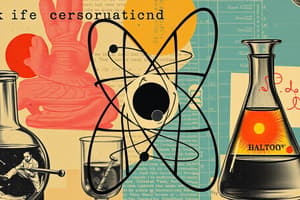Podcast
Questions and Answers
Which statement accurately reflects Dalton's atomic theory?
Which statement accurately reflects Dalton's atomic theory?
- All atoms of a specific element possess uniform mass and characteristics. (correct)
- Atoms of different elements can have identical masses due to the existence of isobars.
- Atoms are divisible into subatomic particles like protons, neutrons, and electrons.
- Molecules are the smallest units of a compound that can exist in a free state.
Which of the following observations contradicts Dalton's postulate that atoms of different elements have different masses?
Which of the following observations contradicts Dalton's postulate that atoms of different elements have different masses?
- Discovery of electrons.
- Discovery of neutrons.
- Discovery of isotopes.
- Discovery of isobars. (correct)
How did J.J. Thomson's experiments contribute to the understanding of atomic structure?
How did J.J. Thomson's experiments contribute to the understanding of atomic structure?
- They revealed that atoms contain negatively charged particles called electrons. (correct)
- They confirmed that all atoms of a given element are identical in mass.
- They demonstrated that atoms are indivisible.
- They provided evidence for the existence of neutrons in the nucleus.
According to Thomson's plum pudding model, what accounts for the overall neutral charge of an atom?
According to Thomson's plum pudding model, what accounts for the overall neutral charge of an atom?
What was a significant limitation of Thomson's atomic model?
What was a significant limitation of Thomson's atomic model?
In Rutherford's gold foil experiment, what observation led him to conclude that most of the atom is empty space?
In Rutherford's gold foil experiment, what observation led him to conclude that most of the atom is empty space?
According to Rutherford's model, where is most of the mass of an atom concentrated?
According to Rutherford's model, where is most of the mass of an atom concentrated?
What key aspect of atomic structure did Rutherford's model fail to adequately address?
What key aspect of atomic structure did Rutherford's model fail to adequately address?
Which of the following is a limitation of Rutherford's atomic model based on classical physics?
Which of the following is a limitation of Rutherford's atomic model based on classical physics?
What is the significance of Niels Bohr's contribution to atomic theory?
What is the significance of Niels Bohr's contribution to atomic theory?
According to Bohr's model, what happens when an electron transitions from a higher energy level to a lower energy level?
According to Bohr's model, what happens when an electron transitions from a higher energy level to a lower energy level?
In Bohr's atomic model, what is the ground state of an electron?
In Bohr's atomic model, what is the ground state of an electron?
What does the emission spectrum of an element represent, according to Bohr's theory?
What does the emission spectrum of an element represent, according to Bohr's theory?
Which formula can be used to calculate the radius of Bohr's orbit for hydrogen-like species?
Which formula can be used to calculate the radius of Bohr's orbit for hydrogen-like species?
What is a limitation of Bohr's atomic model regarding spectral lines?
What is a limitation of Bohr's atomic model regarding spectral lines?
Bohr's atomic model primarily applies to which type of species?
Bohr's atomic model primarily applies to which type of species?
What type of spectrum shows only certain colors or specific wavelengths of light?
What type of spectrum shows only certain colors or specific wavelengths of light?
Which series in the hydrogen spectrum falls within the visible region?
Which series in the hydrogen spectrum falls within the visible region?
What type of spectrum is produced when white light passes through a substance, resulting in dark lines where certain wavelengths have been absorbed?
What type of spectrum is produced when white light passes through a substance, resulting in dark lines where certain wavelengths have been absorbed?
An electron transitions from $n=3$ to $n=2$ energy level in a hydrogen atom. Which series does this transition belong to?
An electron transitions from $n=3$ to $n=2$ energy level in a hydrogen atom. Which series does this transition belong to?
Flashcards
Dalton's Atomic Theory (Postulate 1)
Dalton's Atomic Theory (Postulate 1)
All matter consists of indivisible and indestructible atoms.
Dalton's Atomic Theory (Postulate 2)
Dalton's Atomic Theory (Postulate 2)
All atoms of a given element are identical in mass and properties.
Dalton's Atomic Theory (Postulate 3)
Dalton's Atomic Theory (Postulate 3)
Compounds are formed by combining two or more different kinds of atoms.
Dalton's Atomic Theory (Postulate 4)
Dalton's Atomic Theory (Postulate 4)
Signup and view all the flashcards
Limitation of Dalton's Theory
Limitation of Dalton's Theory
Signup and view all the flashcards
Isotopes
Isotopes
Signup and view all the flashcards
Molecules vs Atoms
Molecules vs Atoms
Signup and view all the flashcards
Neutral Charge
Neutral Charge
Signup and view all the flashcards
Thomson's Atomic Model (Postulate 1)
Thomson's Atomic Model (Postulate 1)
Signup and view all the flashcards
Thomson's Atomic Model (Postulate 2)
Thomson's Atomic Model (Postulate 2)
Signup and view all the flashcards
Rutherford's Gold Foil Experiment
Rutherford's Gold Foil Experiment
Signup and view all the flashcards
Rutherford's Model - Mass
Rutherford's Model - Mass
Signup and view all the flashcards
Rutherford's Model - Electrons
Rutherford's Model - Electrons
Signup and view all the flashcards
Bohr's Atomic Model
Bohr's Atomic Model
Signup and view all the flashcards
Energy levels
Energy levels
Signup and view all the flashcards
Excited state
Excited state
Signup and view all the flashcards
Radiation energy
Radiation energy
Signup and view all the flashcards
Stable orbits
Stable orbits
Signup and view all the flashcards
Line spectrum
Line spectrum
Signup and view all the flashcards
Wave number
Wave number
Signup and view all the flashcards
Study Notes
- Atomic theory postulates: all matter consists of indivisible and indestructible atoms.
- Atoms of a particular element will have identical masses and properties.
- Compounds arise from combinations of two or more different kinds of atoms.
- Chemical reactions involve only the rearrangement of atoms.
Limitations of Dalton's Theory
- Atoms are divisible into protons, neutrons, and electrons, contradicting Dalton's initial postulate.
- Isotopes exist, meaning atoms of the same element have the same mass as Dalton stated.
- Isobars exist, meaning atoms of different elements can have the same mass, contrary to Dalton. Tellurium (atomic number 52) and iodine (atomic number 53) both have an atomic mass of 127
- Atoms are the smallest part of elements, molecules are the smallest part of compounds.
J.J. Thomson's Contribution
- J.J. Thomson (1856-1940) discovered the electron.
- Thomson's gifted teaching led to many Nobel Prizes won by his students and research assistants.
- Subatomic particles were discovered at this time.
Discovery of the Electron
- British physicist J.J. Thomson proved atoms aren't indivisible in 1897.
- Thomson used a high-voltage source with electrodes sealed in an evacuated glass tube known to have a cathode (negative electrode).
- The tube emitted a greenish light caused by the interaction of glass with cathode rays.
- Cathode rays consist of beams of negatively charged particles (electrons).
- The electrons are also constituents of all matter.
Plum Pudding Model
- Thomson's plum pudding model proposed that atoms have an overall neutral charge, with negative particles floating in a soup of diffuse positive charge.
- An atom has a positively charged sphere with embedded electrons, and is electrically neutral overall.
- The plum pudding model failed to explain how the positive charge holds electrons or an atom's stability.
- This model did not describe a nucelus.
Rutherford's Gold Foil Experiment and Idea of the Nucleus
- Rutherford projected alpha (α) particles at 180,000 miles per second onto gold foil in 1911.
- The alpha-scattering experiment showed that most alpha particles passed through, a few scattered at large angles, and some bounced back.
Rutherford's Atomic Model
- Most of the atomic space is empty.
- The mass of an atom is concentrated in the center of the nucleus that's positively charged, comprising 99.95% or more of atom mass.
- Electrons move around the nucleus.
- Total electrons = number of positively charged particles in the nucleus; therefore the atom is electrically neutral.
- The inward electrostatic attraction is balanced by the centrifugal force from electron rotation.
Limitations of Rutherford's Model
- Rutherford stated the electrons revolve in orbits. Maxwell stated accelerating charged particles emit electromagnetic radiation.
- An electron would lose energy and spiral into the nucleus in less than 10^-8 seconds.
- Rutherford's model did not account for electron arrangement, making the theory incomplete.
- He did not describe the shape of the orbits.
Max Planck
- Max Planck (1858-1947) rendering of services led to the advancement of physics for his discovery of energy quanta (1918 Nobel Prize in Physics).
Niels Bohr
- Niels Bohr (1885-1962) conducted investigations of the structure of atoms and the radiation emanating from them (1922 Nobel Prize in Physics).
G.P. Thomson
- G.P. Thomson (1885-1962) conducted experimental discovery of the diffraction of electrons by crystals (1937 Nobel Prize in Physics).
Aage Niels Bohr
- Aage Niels Bohr (1922-2009) made a discovery of the connection between particle and collective motion in atomic nuclei (1975 Nobel Prize in Physics).
Bohr's Atomic Model
- Niels Bohr's model contributed understanding to atomic structure and quantum mechanics in 1913.
- It introduced the electron and nucleus.
- When an electron revolves in this orbit, it doesn't irradiate energy and need not lose energy.
- Quantization of angular momentum occurs with each electron.
- Each orbit is called a shell or energy level, containing certain energy.
- An electron absorbs energy when moving from a lower energy level to a higher one, causing an excited state.
- When electrons move from one orbit to another, they emit photons that produce absorption and emission spectra.
- Spectra can determine material composition.
- Orbits closer to the nucleus are more stable, representing the grand state.
Calculation of Radius of Bohr's Orbit
radius of orbit = r = (n²h² / 4π²me²) x (1/Z) = 0.529 x (n²/Z) Å
- n = principal quantum number of orbit
- Z = atomic number
Formula for Velocity
Vn = (2πZe²/h) x (Z/n)
Formula for Energy
En = - (2π²me^4 / n²h²)
Limitations to Bohr's Atomic Model
- Only shows spectra of single-electron species like hydrogen.
- Only predicted one spectral line.
Spectrum
- White light through a prism resolves into color components and is therefore part of the spectrum.
- Line Spectrum: Spectrum displaying specific wavelengths
- Continuous spectrum: Spectrum of all wavelengths
- Emission spectrum: Atoms or molecules heated, emit light (bright)
- Absorption spectrum: White light is passed through substance (dark)
Emission Spectrum of Hydrogen
- Hydrogen spectrum is an important piece of evidence to show the quantized electronic structure.
- Line, or hydrogen, is emitted by energetics.
- Rydberg proposed a math formula.
Studying That Suits You
Use AI to generate personalized quizzes and flashcards to suit your learning preferences.
Related Documents
Description
Explore Dalton's atomic theory postulates, including the indivisibility of atoms and the properties of elements. Review the limitations of Dalton's theory, including isotopes and the existence of subatomic particles. Learn about J.J. Thomson's discovery of the electron.




